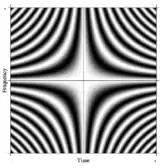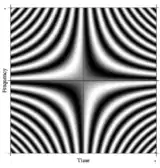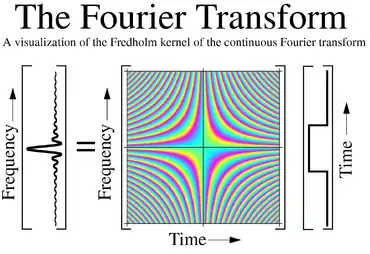Fourier operator
The Fourier operator is the kernel of the Fredholm integral of the first kind that defines the continuous Fourier transform.


It may be thought of as a limiting case for when the size of the discrete Fourier transform increases without bound while its spatial resolution also increases without bound, so as to become both continuous and not necessarily periodic.
As a teaching tool the Fourier operator is used widely and it has also been used as an art form, including the book cover of the book Advances in Machine Vision (ISBN 9810209762).
Visualization of the Fourier transform as the result of the Fourier operator
The Fourier operator defines a continuous two-dimensional function that extends along time and frequency axes, outwards to infinity in all four directions. This is analogous to the DFT matrix but, in this case, is continuous and infinite in extent. The value of the function at any point is such that it has the same magnitude everywhere. Along any fixed value of time, the value of the function varies as a complex exponential in frequency. Likewise along any fixed value of frequency the value of the function varies as a complex exponential in time. A portion of the infinite Fourier operator is shown in the illustration below, which depicts how it acts on a rectangular pulse to generate its Fourier transform (in this case, a sinc function):

Any slice parallel to either of the axes, through the Fourier operator, is a complex exponential, i.e. the real part is a cosine wave and the imaginary part is a sine wave of the same frequency as the real part.
Diagonal slices through the Fourier operator give rise to chirps. Thus rotation of the Fourier operator gives rise to the fractional Fourier transform, which is related to the chirplet transform.
